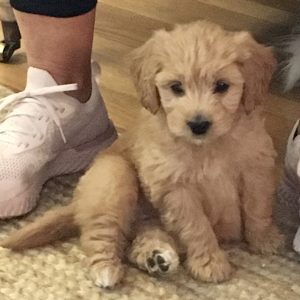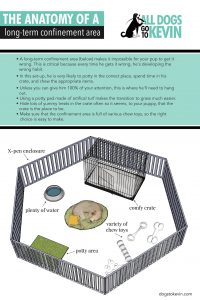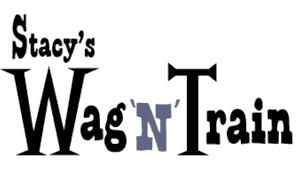Help that little one stay OUT of trouble!
© Stacy Braslau-Schneck, CPDT
So you have this adorable but very active puppy, and a house full of things that you don’t want the pup to destroy. How do you reconcile the two? Here’s the simple recipe:
- Give the puppy ample opportunity to get it right, and reward him if he does.
- Limit the opportunity to get it wrong, and stop him if he does.
- When you can’t be there to reward or stop him, limit his choices so he doesn’t guess wrong.

It is your job, as puppy-owner, to teach your puppy how to be responsible for his own behavior. But to do this, the pup needs to know what is appropriate, and what isn’t. Face it: dogs pee, poop, chew, pick things up, play rough, and dig. This is part of dog nature, and it is impossible or at least very difficult to stop them completely. But you can channel it. Puppies need an appropriate outlet for each of these activities. And they need to be told what that appropriate outlet is.
Housebreaking

The secret to teaching a dog where to “go” is (1) to very frequently take him to the appropriate spot and reward him (praise, games, and treats) when he uses it, and (2) to be extremely vigilant and prevent him from going in the inappropriate spot. In fact, you should give them almost no opportunity to “go” in the wrong place. Don’t even let your puppy loose in the house until you know he has already “gone” outside. Read more in the next next Training Tip: Housetraining Your Puppy.
Chewing
Designate specific items that are appropriate to chew. Don’t just give him a chew toy. Encourage him to play with it (you can tease him with it a little and make it seem more alluring), and praise him for chewing on it. Don’t make him guess what items in your house aren’t chew toys. When you allow your puppy into a room of your house (after he’s successfully used his potty spot, of course), first clear it of anything you don’t want him to chew on (just place it out of your pup’s reach), and regularly treat the surfaces of your furniture with a taste deterrent like Bitter Apple, Yuck, or some similar chew-deterrent spray (found at most pet stores).
When your puppy is comfortable chewing his Kong or other food-stuffed toy (you could also try pigs’ ears, bully sticks, Himalayan yak chews, etc.) in your living room, gradually, under your supervision, start returning some of your regular items to their normal spots. Let him investigate them, but prevent him from picking up or chewing things you want him to leave alone. Teach your puppy “leave it” and use that if he tries to take something he shouldn’t. Encourage him to stick with his chewies — they’ll give him the chewing pleasure he needs and also earn him praise from you. But try not to hover over him, constantly directing his every move. He’s going to need to learn to be responsible for his own behavior, without your direction.
Picking Things Up
Encourage your puppy to pick up his toys. Praise him for it. Then, teach him “drop it”. Don’t leave a lot of opportunities for mistakes — pick up your socks and leave your valuables out of reach until your pup learns that it’s not as rewarding to pick those up as it is to play with his legal toys. Practice object exchanges, where the puppy trades you something he’s got for something you’ve got. (Don’t chase him around the house unless you want your puppy to grab things and run away!) When he’s quite good at bringing you things and dropping them on command, allow him, supervised, around your stuff.
Playing rough
Give your puppy an appropriate time, place and outlet for running, grabbing things, and making a lot of noise! Encourage him to race around the back yard, play enthusiastically but safely with other dogs, toss around and chase his toys. Give him a Kibble Nibble or Buster Cube to knock around, or a jolly ball to push with his nose. Teach a cue to start and to stop a tug-of-war game; if you control the beginning and ending of the game it’s a great outlet and will actually increase your status as “pack leader”. (See games for more information.) If he plays too roughly in the house, interrupt him and send him outside to play. If your pup learns that “outside” is the place for running and playing, he’s less likely to do it inside near the china cabinet.
Digging
If your pup likes to dig, choose a spot in your yard to be the pup’s digging area. A good idea is to fill this area with sand (it’s easier to clean off them). Praise him for digging there. You can even bury toys or treats in the sand for him to find. If he digs in other parts of the garden, stop him and bring him over to his sandbox. When you’re not around to supervise, keep him out of the yard or fence off the areas where his gardening opinions are not wanted.
Note: In general, be sure to give your dog lots of mental and physical exercise, and he will be content to be a non-destructive couch potato when you’re not around Most destructiveness comes from boredom, pent-up energy, and loneliness. See the Games page for some ideas! If your dog is confident in understanding the appropriate time and place for his actions, he is less likely to do those things inappropriately.
When you’re not there to direct his actions during the learning stages, you must eliminate any possibility that pup will be rewarded for whatever you don’t want him to be doing. That usually means enclosing him in a crate, dog run, or dog-proofed room of the house when you can’t supervise him. (See the Quick Fixes for Problem Behaviors for more ideas). Teach him to enter and exit this safe place on command, and make sure it’s comfortable and attractive for him.
Eventually, you should have a young dog and a house that can co-exist quite comfortably!
Thanks to Val Ellingson, Mary Ochadlik, and Jean Donaldson for ideas and experience!
There are FIVE main priorities for the owners of young puppies: Housetraining, play-biting, chewing, alone-training, and socialization. I can help you with each of these, as well as basic training, and behavior problem-solving! See these other Training Tips, Housetraining Your Puppy and Play-Biting for some of these issues. To set up an appointment to get personalized help with all puppy issues, email me at stacy@wagntrain.com or see the Services page.
Poem for New Puppy Owners
Don’t smell crotches,
Don’t eat plants.
Don’t steal food
Or underpants.
Don’t eat my socks,
Don’t grab my hair. . .
DON’T RIP THE STUFFING
FROM THAT CHAIR!
Don’t eat those peas!
Don’t touch that bush!
Don’t chew my shoes. . .
What IS that mush?
Eat your cookie,
Drink your drink,
Outta the toilet!
Outta the sink!
AWAY FROM THE CAT BOX,
IT’S FOR THE CAT!
(And MUST you kiss me
After that???)
Yes, raising a puppy,
Is not for the lazy.
Though puppies are funny,
They’re also quite crazy.
But don’t despair
Though it’s toil and strife,
After 3 years
You’ll get back your life!
So, let’s go for “walkies,”
You can “do your thing”
(And perhaps I’ll get back
MY GOOD DIAMOND RING!)
© Judith Belsham Singer
Written June 30, 2012; updated February 2019 by Stacy Braslau-Schneck.
All material copyright Stacy Braslau-Schneck unless otherwise noted. Reprints for non-commercial use, and with the authors’ permission only. Would you, your training company, or your club like to reprint this? Please be sure to keep my name, business name, and the website URL with the article, and if possible, please send me a copy. See the Contact Page for email and mailing address.
updated February 2023

